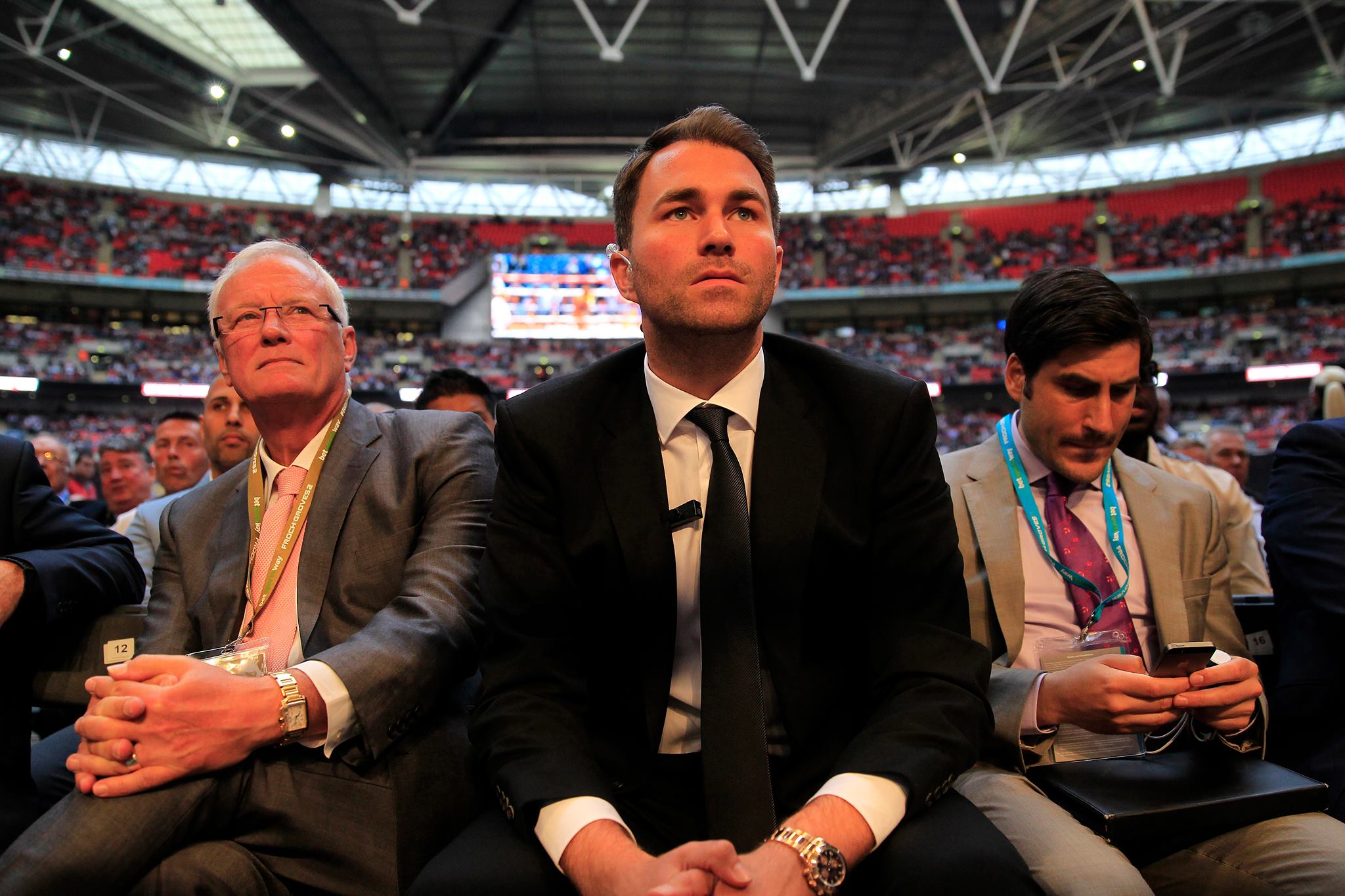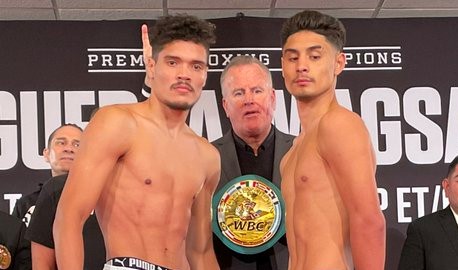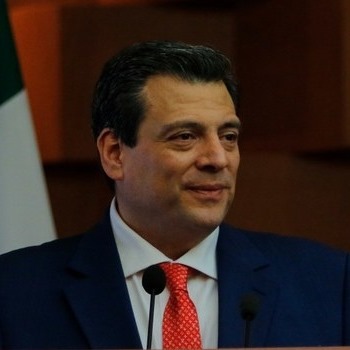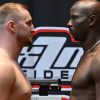There are fights that were great within the ring but for me, there are five fights that transcended the sport. These fights did not transcend the sport because of what happened in the ring but what they represented outside the ring. The first such fight was the John L Sullivan-Gentleman Jim Corbett. This fight was a one sided affair as Corbett easily outclassed Sullivan, whose suffered the effect of a life of booze and age. Corbett was a quick boxer whose scientific approach became the model for boxers who followed and this fight transited the sport from the old bare knuckles to the glove era. Sullivan began his career as a bare knuckle fighter and in the early 1890’s, the glove era took over from the bare knuckle fighters.
Sullivan was the opposite of Corbett. Corbett was scientific, good looking with a matinee appearance and had some education whereas Sullivan spent much of his training in bars and often would challenge many of bar patrons to a fight. As a sport, boxing often got forced into the underground as it was illegal in many states but Gentleman Jim Corbett represented a different face for the sport. As the sport gained in popularity, it moved into the mainstream and Corbett was one reason that the sport made it move into the center of sport world. The Corbett-Sullivan began the process of moving into the glove sport that we know today and Corbett victory ended forever the bare knuckle era and from this point, the sport we see today is similar to the Corbett-Sullivan.
The Tunney-Dempsey II was more than a fight, it was an event. After losing his title the year before; Dempsey defeated an up and coming fighter in Jack Sharkey to gain his second shot at Gene Tunney. Tunney was a slick boxer with pop in his punches and Jack Dempsey was the prototype brawler who could end a fight with one punch.
This fight reflected the roaring 20’s as America saw economic boom times and a new technology, radio, brought the sporting world right into the living room of fans. Dempsey was a big draw and one of the big sporting figures along with Babe Ruth and Red Grange. Many of his bigger fights brought in million dollar gates, an unheard figure the decade before. The second Tunney-Dempsey was fought in Chicago Soldier Field and crowd was one of the biggest, if not biggest, live gate in boxing history.
The fight turn out to be the last big sporting event of the decade as two years later, the decade ended with the big stock market crash and the beginning of a decade long depression. As for the action within the ring, Tunney easily dominated the first six rounds as he dominated the action the year before. Dempsey showed his explosive self as he threw a combination that knocked Tunney down. A new rule was instituted before the fight, if there was a knock down; the fighter had to move into a neutral corner. Dempsey was always close to an opponent when he knocked an opponent down, which was the rule of the time. Like a wild cat, he was ready to pounce but on this night, he did not move to a neutral corner. Tunney was given extra time while the referee stopped the count to move Dempsey to a neutral corner and for the rest of the round; he retreated as he gained his wits back. This fight would be forever remembered as the long count and the question was whether Tunney would have gotten up if the referee did not stop the count. This long count took on a legend on its own but what was forgotten was the next round.
Tunney return the favor and knocked Dempsey down and then coasted the rest of fight. The long count hid the fact that Tunney essentially took almost every round of both fights. The fight reflected the time as both fighters received big dollars and the big salaries foreshadowed what happened in the sporting world post World War II. Today, big events present big dollars as both Pacquaio and Mayweather will receive millions but Dempsey was the original big dollar fighter and his promoter Tex Rickard was the big promoter of his day. It could be said that Rickard was Bob Arum and Don King combine in one.
Vietnam divided the nation and Muhammad Ali became a symbol of opposition to the war as he refused induction into the Army. His joining the Nation of Islam only added to the split feeling about Ali. We view Ali today as the lovable personality but in 1971, he was a member of a Black separatist movement combined with opposing the war, making Ali equally reviled and loved. His opponent, Joe Frazier, became symbolic of the establishment by default.
Frazier viewed himself as a fighter but in the build up to the first Ali-Frazier fight, he sucked into a vortex beyond his control. He could no longer control his own destiny or image as he became the foil to Ali. The Ali-Frazier I became the big event and may have been one of the three most important sporting events in the 20th century. (The other two being Louis-Schmeling II and Johnson-Jefferies)
In a fight that was both dramatic and close, both fighters pummeled each other for 15 rounds before Frazier won a close but unanimous decision. This was a fight with ebb and flow like in the ninth round when it appeared that Ali turned the fight in his favor with a swift combinations including connecting right hands to Frazier face or the eleventh round in which a Frazier left hook nearly swung Ali 180 degrees. The fifteen round saw Frazier put an exclamation mark as he knocked Ali down to clinch the decision. While both fighters would have two more brutal fights in one of boxing great trilogies, this fight had meaning beyond the ring.
Frazier-Ali combined opposition to a war and the question of race, Jack Johnson-Jim Jefferies was strictly about race. Johnson became the World champion when he defeated Tommy Burns. Throughout 1908, Johnson chased Burns everywhere and taunted him at bouts, often from the front row. Burns relented for what was then big dollars in Australia but he proved no match for the bigger and stronger Johnson. When he defeated Burns, Johnson defeated the best White fighter. (Often history viewed this match as a mismatch and on paper it was. Burns was the smallest heavyweight in Heavyweight championship history but before he met Johnson, he went around the world to beat the best fighters of his era. He also defeated Marvin Hart for the championship who previously defeated Johnson. While many view Jefferies as Johnson’s toughest but his toughest opponent during his championship reign may have been Burns)
Jefferies was called out of a six year retirement to defend the honor of the White Race. Six year earlier, Jefferies dominated the heavyweight division, having beaten Gentleman Jim Corbett twice and Bob Fitzsimmons. Jefferies at his peak was a killing machine combining athleticism and strength. For many boxing fans, they remembered Jefferies at his peak but the reality was that he was hundred pounds overweight when he said yes to the fight. Johnson not only held the crown but he also dated white women, a big no-no in the early 20th century and illegal in many states at the time. Johnson challenged the very fabric of the racial caste of the early 20th century.
Jefferies came into the fight as a slight favorite despite having to lose 100 pounds in training and having not fought in six years. The fight was a one sided affair as Johnson youth, and superior speed dominated the actions and Jefferies no longer had the skills that made him great at the turn of the century. By the fifteenth round, Jefferies face were swollen and his leg rubbery and Johnson finished off the former champion by knocking him down three times before the fight was stopped.
Much of crowd were stunned and race riots ensued after the fight throughout the United States as white clashed over blacks celebrations. As for Johnson, he was indicted for violating the Mann act which prohibited “taking women across state lines for immoral purposes.” Johnson cavorted with prostitutes, including Lucy Cameron who eventually married Johnson. When Cameron refused to cooperate with authorities, another woman came forward to cooperate and help the state get their conviction. After his lost to Jess Willard, Johnson surrendered to authorities and served a year sentence. For the next twenty two years, no blacks fought for the heavyweight title before Joe Louis. The irony was that race played a role in Joe Louis getting his title shot.
Going into 1936, Louis was undefeated going into the first Max Schmeling fight with the winner possibly getting a title shot at James Braddock. Louis was the heavy favorite but Schmeling upset him with a twelfth round knockout, leaving the German as the logical contender. The problem was that if Schmeling actually won the title, there was a good chance the Nazis would have simply not allowed Schmeling fight again. Certainly with a German with the Heavyweight title, it meant that the Nazis would control the world most prestigious title.
There was a movement afoot to allow Louis fight Braddock for the title and deal was struck that allowed Braddock to garner ten percent of Louis future purses. Louis got his title shot despite losing to Schmeling and defeated Braddock in a bloody affair. Louis never forgot his lost to Schmeling and he wanted his own revenge for he never felt that he could truly be champ unless he defeated Max Schmeling.
In 1938, war fever was starting to grip the world as Hitler Germany was threatening the peace. Joe Louis, an Africa-American, represented America and all that was good whereas Max Schmeling represented Nazis Germany. (Schmeling was not a member of the Nazis Party and even risked his life to help some Jews during the pre World War II era. Yet, he never truly opposed the regime and fought for Germany during the War.)
The fight lasted two minutes as Louis pulverized Schmeling. Unleashed by revenge and a desire to fight for his country, Louis fought like a man possessed. He overwhelmed Schmeling as he knocked him down and out. For two minutes, America was colorblind but the aftermath of the fight changed race relations. For many Americans, their own attitude toward race changed as sports writer Jimmy Cannon observed that Joe Louis was a credit to “his race, the human race.”
Louis was the anti-Johnson, whose quiet demeanor was more accepting to White America. His promotional team had several rules for Louis including no public dating of white women and no taunting of opponents. After the fight, Louis became an American hero and respected, becoming the first African-American who attracted white fans in the millions. His popularity was not limited to Black America and much of the benefits would become obvious after the war.
After the war, the major sports integrated along with the armed services and Joe Louis named his successor when he retired. Louis decreed that the winner of the Ezzard Charles and Jersey Joe Walcott fight be deemed the champion. Unfortunately for Louis, he was stuck with delinquent tax bills due to mismanagement by his team. The IRS would hound Louis, forcing him to fight again.
The irony is that Max Schmeling would become fast friends with Joe Louis, even helping Louis’ debt and became a pall bearer at Louis funeral. If Johnson engendered anger in White America, Louis engendered respect and his victory changed race relations.
There were many great fights including Zale-Graziano trilogies as well as the Pep-Sadler series but these fights were great events in the ring but did not have the same impact outside the ring. Four of these five fights were essentially one sided affairs. Louis stopped Schmeling in two minutes, Johnson dominated Jefferies, Tunney won almost every round in his two fights with Dempsey even though the seventh round in the second round is what made the fight and Corbett outclassed Sullivan. Only Ali-Frazier lived up to the hype in the ring.
Corbett-Sullivan was the changing of the guard as Corbett became the new face of boxing and allowed boxing to become mainstream. Tunney-Dempsey reflected the roaring 20’s as both Tunney and Dempsey made big dollars for their two fights. Dempsey became a rich superstar throughout the decade and this despite not fighting for three years during the decade. Dempsey superstar status allowed him to make the big bucks with little work compare to heavyweights of the past. Dempsey foreshadowed the modern era of boxing where superstar boxers can make a lifetime income in one fight. Today fighters no longer need to fight months after months to make a living if they are superstar. Dempsey was no different and he lived in a era in which Babe Ruth once commented that the reason that he got paid more than the President if that he had a better year.
Ali-Frazier put America fissure in the open as both fighters become symbols of the various sides in the political debate from black separatists to anti-war movement and the silent majority. Johnson and Louis represented the two sides of the racial coin for Johnson represented all that was bad about race in America whereas Louis gave us a pause to rethink about race in a more positive way. All of these fights became symbolic of the time they were conducted. These fights surpassed the sport.


















